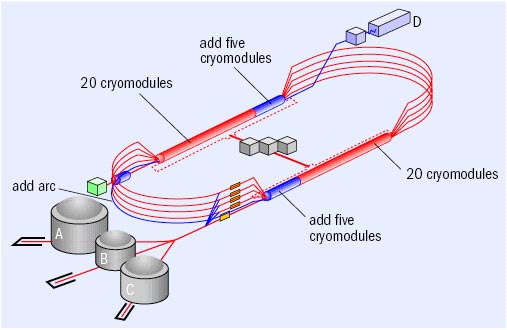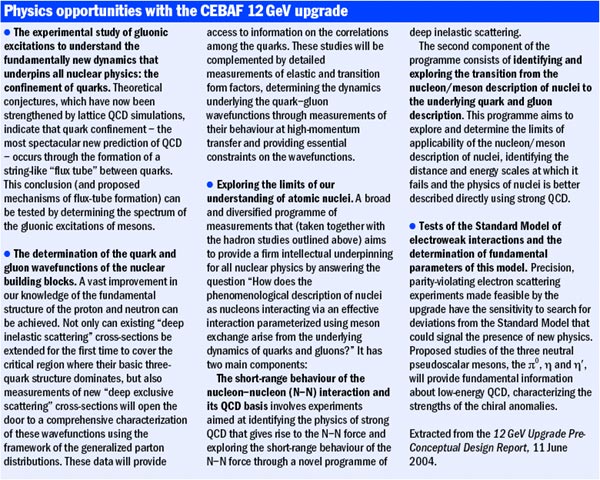Jefferson Lab is aiming to further studies of strongly interacting matter by upgrading the Continuous Electron Beam Accelerator Facility to 12 GeV and adding a fourth experimental hall. Steven Corneliussen reports.
The US Department of Energy (DOE) has placed Jefferson Lab in Newport News, Virginia, on a path towards a major upgrade of the Continuous Electron Beam Accelerator Facility (CEBAF). In April, the DOE announced “critical decision zero” (CD-0) for the laboratory’s proposal to double the superconducting accelerator’s energy from 6 to 12 GeV, add a fourth experimental hall and upgrade equipment in the three existing halls. This step establishes the “mission need” and moves the upgrade into a formal project-definition phase.
CEBAF already offers unique capabilities for investigating the quark-gluon structure of hadrons, particles that interact via the nuclear strong force. The accelerator’s scientific users number in excess of 2000, and more than half of these users are currently active on experiments. Because user demand far exceeds available beam time, the backlog for each experimental hall is at least three years. Since operations began nearly a decade ago, more than 100 experiments have been completed, deepening understanding of strongly interacting matter.

Nevertheless, careful study by users and by the US Nuclear Science Advisory Committee has shown that a straightforward, comparatively inexpensive upgrade of CEBAF offers tantalizing prospects for achieving still deeper understanding. Accordingly, Facilities for the Future of Science: A Twenty-Year Outlook, published by the DOE (p13) in November 2003, recommended the 12 GeV upgrade as a near-term priority. In plain language, the 20 year plan explained why: “Quarks are the particles that unite to form protons and neutrons, which, with electrons, combine to form the atoms that make up all the matter that we are familiar with. As yet, scientists are unable to explain the properties of these entities – why, for example, we do not seem to be able to see individual quarks in isolation (they change their natures when separated from each other) or understand the full range of possibilities of how quarks can combine together to make up matter.”
The physics reach
Experiments at CEBAF have already led to a better understanding of a variety of aspects of the structure of nucleons and nuclei and the nature of the strong force. These include the distributions of charge and magnetization in the proton and neutron; the distance scale where the underlying quark and gluon structure of strongly interacting matter emerges; the evolution of the spin structure of the nucleon with distance; the transition between strong and perturbative quantum chromodynamics (QCD, the field theory of quarks and gluons); the size of the constituent quarks; and possible new states of strongly interacting matter. The upgrade will allow important new thrusts in these areas, generally involving the extension of measurements to substantially higher values of momentum transfer, probing correspondingly smaller distance scales. Moreover, many experiments that can run at a currently accessible momentum transfer will run more efficiently at higher energy, consuming less beam time.

The higher energy of 12 GeV will also mean qualitative changes for CEBAF’s physics reach in two areas in particular. First, the upgrade will cross the threshold above which the origins of quark confinement can be investigated. Specifically, 12 GeV will enable the production of certain “exotic” mesons, the discovery and spectrum of which will establish the origin of quark confinement as being due to the formation of QCD flux tubes, and the spectrum of which encodes information about the mechanism within QCD that is responsible for their formation. If these exotic mesons are not found, their absence will seriously challenge our present understanding of “strong” QCD, and the meson spectra that will be accumulated with unprecedented statistics (including spectra of mesons containing strange quarks and antiquarks) will provide essential information for revising that theory.

A second important area will be the direct exploration of the quark-gluon structure of hadrons and nuclei. It is known that inclusive electron scattering at the high momentum and energy transfers available at 12 GeV is governed by elementary interactions with quarks and gluons. CEBAF’s original design energy was adequate for entering the deep inelastic scattering regime but continuous 12 GeV beams will provide clean access to hadron structure throughout the entire “valence quark region”. This will allow exploitation of the generalized parton distributions so as to experimentally access both the correlations in the quark wavefunctions of the hadrons and their transverse momentum distributions. The higher-energy beams will also allow precise identification of the limits of the long-standing nucleon- and meson-based description of nuclei, as well as full access to and characterization of the transition from this description to the underlying quark-gluon description.
The experimental environment
The CEBAF accelerator consists of a pair of superconducting radiofrequency linacs linked by recirculation arcs for up to five acceleration passes. It serves three experimental halls with simultaneous, continuous-wave beams, originally with a final energy of up to 4 GeV but now with one of up to 6 GeV thanks to incremental improvements in cryomodule technology. The complex experimental programme often requires independent beams to the three halls, each with fully independent current, a dynamic range of 105, high beam polarization and “parity quality” constraints on energy and position. To meet these varied demands, the machine undergoes about one change in configuration per week and must routinely operate at 5.5 GeV or higher.
For the upgrade, a new hall (Hall D) will be built at the end of the accelerator opposite the present Halls A, B and C. There, experimenters will use collimated beams of linearly polarized photons at 8-9 GeV, produced by coherent bremsstrahlung from 12.1 GeV electrons. To send a beam of that energy to that location requires a sixth acceleration pass through one of the linacs. This means adding a recirculation beamline to one of the arcs, and also requires augmenting the accelerator’s present 20 cryomodules with 10 new, higher-performing ones. Maximum energy for five passes will rise to 11 GeV for the three original halls, with experimental equipment upgraded in each. The 2 K helium refrigeration plant will be upgraded to 10.1 kW from the present 4.8 kW.
In December 2002, the DOE Office of Science asked the Ad-hoc Facilities Subcommittee of the US Nuclear Science Advisory Committee (NSAC) to review all proposed projects once again. The report declared the science programme of the 12 GeV upgrade “absolutely central” to progress in the field, and the project “ready for construction”. The remaining R&D will be focused on optimizing cost and increasing technical contingency. With this year’s CD-0 decision, Jefferson Lab is moving the project forward with enthusiasm.
For the more distant future, research needs beyond the 12 GeV upgrade are also being considered. That science would require high luminosity and still higher energies. Essential concepts and technology advances are under study.
• For more information see the “CEBAF @ 12 GeV” link at the website www.jlab.org.





